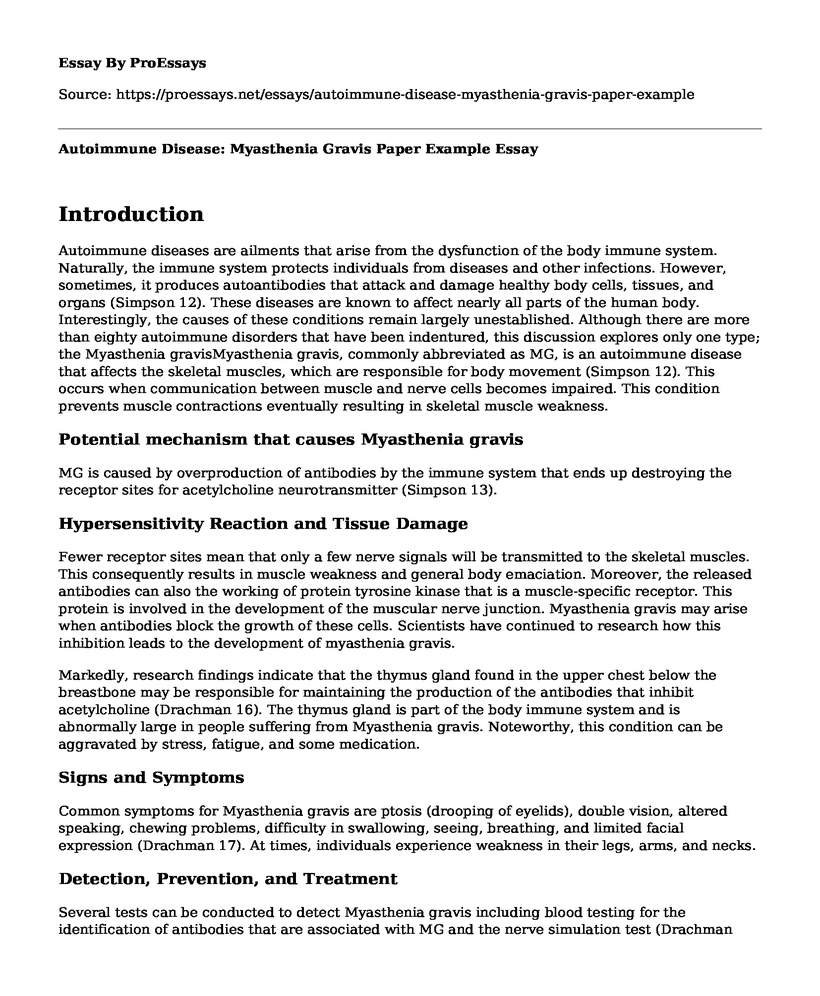Introduction
Autoimmune diseases are ailments that arise from the dysfunction of the body immune system. Naturally, the immune system protects individuals from diseases and other infections. However, sometimes, it produces autoantibodies that attack and damage healthy body cells, tissues, and organs (Simpson 12). These diseases are known to affect nearly all parts of the human body. Interestingly, the causes of these conditions remain largely unestablished. Although there are more than eighty autoimmune disorders that have been indentured, this discussion explores only one type; the Myasthenia gravisMyasthenia gravis, commonly abbreviated as MG, is an autoimmune disease that affects the skeletal muscles, which are responsible for body movement (Simpson 12). This occurs when communication between muscle and nerve cells becomes impaired. This condition prevents muscle contractions eventually resulting in skeletal muscle weakness.
Potential mechanism that causes Myasthenia gravis
MG is caused by overproduction of antibodies by the immune system that ends up destroying the receptor sites for acetylcholine neurotransmitter (Simpson 13).
Hypersensitivity Reaction and Tissue Damage
Fewer receptor sites mean that only a few nerve signals will be transmitted to the skeletal muscles. This consequently results in muscle weakness and general body emaciation. Moreover, the released antibodies can also the working of protein tyrosine kinase that is a muscle-specific receptor. This protein is involved in the development of the muscular nerve junction. Myasthenia gravis may arise when antibodies block the growth of these cells. Scientists have continued to research how this inhibition leads to the development of myasthenia gravis.
Markedly, research findings indicate that the thymus gland found in the upper chest below the breastbone may be responsible for maintaining the production of the antibodies that inhibit acetylcholine (Drachman 16). The thymus gland is part of the body immune system and is abnormally large in people suffering from Myasthenia gravis. Noteworthy, this condition can be aggravated by stress, fatigue, and some medication.
Signs and Symptoms
Common symptoms for Myasthenia gravis are ptosis (drooping of eyelids), double vision, altered speaking, chewing problems, difficulty in swallowing, seeing, breathing, and limited facial expression (Drachman 17). At times, individuals experience weakness in their legs, arms, and necks.
Detection, Prevention, and Treatment
Several tests can be conducted to detect Myasthenia gravis including blood testing for the identification of antibodies that are associated with MG and the nerve simulation test (Drachman 17). Other tests include the Tensilon test that entails muscle movements under the observation of the doctor and the imagining of the chest using MRI or CT scans to identify the tumor.
Virtually, there is no known way of preventing MG ailments since the causes and cure are unknown. Rather, prevention aims at helping the patient cope with the condition so that he or she can live a normal life. The prevention actions that can be espoused include maintaining proper nutrition, avoiding respiratory diseases, taking anticholinesterase drugs as ordered by the doctor, resting, and minimizing stress (Drachman 18).
Over and above, there is no cure for Myasthenia gravis. The goal of the treatment plan is to help manage symptoms as well as control immune system activities. Immunosuppressant and corticosteroids are used to suppress the body immune system. Again, inhibitors such as pyridostigmine are used to enhance communication between skeletal muscle and nerve cells. Also, patients who are adversely affected may require the removal of the thymus gland. Lastly, plasma exchange can be done to remove excess antibodies.
Works Cited
Drachman, Daniel B. "Myasthenia gravis." New England Journal of Medicine 298.3 (1978): 136-142.
Simpson, John A. "Myasthenia gravis as an autoimmune disease: clinical aspects." Annals of the New York Academy of Sciences 135.1 (1966): 506-516.
Cite this page
Autoimmune Disease: Myasthenia Gravis Paper Example. (2022, Oct 23). Retrieved from https://proessays.net/essays/autoimmune-disease-myasthenia-gravis-paper-example
If you are the original author of this essay and no longer wish to have it published on the ProEssays website, please click below to request its removal:
- Four Ethical Models of a Physician-Patient Relationship Essay
- Gastroesophageal Reflux Disease (GERD) Paper Example
- Essay Sample on Mechanical Debridement
- Research Paper on Supply and Demand in Public Health
- Essay on Old Age Disorders: A Study of Dementia and Beyond
- Latino/Hispanic Communities in US: Alarming HIV Risk & Stats - Essay Sample
- 20th Century Pandemics: Deadly Global Threats With 500K+ US Victims - Essay Sample







